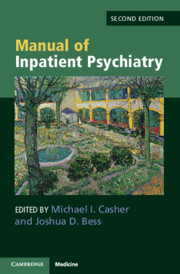Book contents
- Manual of Inpatient Psychiatry
- Manual of Inpatient Psychiatry
- Copyright page
- Contents
- Contributors
- Preface to the Second Edition
- Foreword: American Inpatient Psychiatry in Historical Perspective
- Chapter 1 The Inpatient with Schizophrenia
- Chapter 2 The Inpatient with Depression
- Chapter 3 The Inpatient with Mania
- Chapter 4 The Inpatient with Borderline Personality Disorder
- Chapter 5 The Inpatient with Dementia
- Chapter 6 The Inpatient with Traumatic Brain Injury
- Chapter 7 The Inpatient with Dual Diagnosis (Co-Occurring Disorder)
- Chapter 8 The Young Adult on the Inpatient Unit
- Chapter 9 Clinical Documentation on the Inpatient Unit
- Index
- References
Chapter 3 - The Inpatient with Mania
Published online by Cambridge University Press: 05 March 2020
- Manual of Inpatient Psychiatry
- Manual of Inpatient Psychiatry
- Copyright page
- Contents
- Contributors
- Preface to the Second Edition
- Foreword: American Inpatient Psychiatry in Historical Perspective
- Chapter 1 The Inpatient with Schizophrenia
- Chapter 2 The Inpatient with Depression
- Chapter 3 The Inpatient with Mania
- Chapter 4 The Inpatient with Borderline Personality Disorder
- Chapter 5 The Inpatient with Dementia
- Chapter 6 The Inpatient with Traumatic Brain Injury
- Chapter 7 The Inpatient with Dual Diagnosis (Co-Occurring Disorder)
- Chapter 8 The Young Adult on the Inpatient Unit
- Chapter 9 Clinical Documentation on the Inpatient Unit
- Index
- References
Summary
Most inpatient clinicians have little problem recognizing classic mania, as it presents with a familiar complex of signs and symptoms: elation, expansiveness, rapid speech with flight of ideas, grandiosity, spending sprees, and hypersexuality [1]. A manic episode can usually be differentiated from a psychotic break in schizophrenia in that many manic patients will exhibit people-seeking behavior as well as an overall quality of overactivation (Table 3.1). However, this pattern of acute euphoric mania may be less common than in the past. Increasingly, patients require hospitalization for manic symptoms combined with irritability, suicidal preoccupations, and dysphoric mood (in the older literature, in fact, this syndrome was termed “dysphoric mania”). This is the so-called mixed state, which – depending on one’s definition – 40% of bipolar patients will experience at some point in their clinical course [2].
- Type
- Chapter
- Information
- Manual of Inpatient Psychiatry , pp. 63 - 81Publisher: Cambridge University PressPrint publication year: 2020



